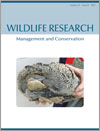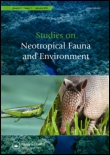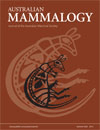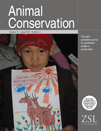
Journal of Fish and Wildlife Management
Scope & Guideline
Navigating the future of fish and wildlife conservation.
Introduction
Aims and Scopes
- Fisheries Management and Conservation:
The journal emphasizes research on sustainable fisheries practices, population dynamics, and management strategies for various fish species, highlighting the importance of informed decision-making in fisheries management. - Wildlife Ecology and Conservation:
Research on wildlife species, their habitats, interactions with ecosystems, and conservation strategies is a core focus. The journal publishes studies that assess population viability, habitat use, and the impacts of anthropogenic activities. - Ecological Research and Methodologies:
The journal promotes innovative research methodologies, including modeling, telemetry, and bioacoustic monitoring, to enhance understanding of ecological dynamics and species interactions. - Human-Wildlife Interactions and Management:
Papers addressing the implications of human activities on wildlife populations and habitats, including land use changes and conservation policies, are prominently featured, reflecting the journal's commitment to integrating social and ecological perspectives. - Biodiversity and Ecosystem Services:
The journal recognizes the importance of biodiversity in ecosystem functioning and services, publishing research that explores the relationships between species diversity, ecosystem health, and management practices.
Trending and Emerging
- Climate Change Impact Studies:
Research examining the effects of climate change on fish and wildlife populations is gaining traction, highlighting the need for adaptive management strategies in response to shifting environmental conditions. - Conservation Genetics and Genomics:
There is an increasing focus on genetic studies that inform conservation strategies, including population viability analyses and the genetic health of species, which are essential for effective management. - Innovative Monitoring Techniques:
Emerging methodologies such as remote sensing, bioacoustic monitoring, and advanced telemetry are being increasingly adopted, facilitating more effective and efficient data collection for wildlife research. - Human-Wildlife Conflict Mitigation:
Research addressing strategies to mitigate human-wildlife conflicts is trending, reflecting the growing need to balance wildlife conservation with human interests and activities. - Ecosystem Services and Management:
The integration of ecosystem services into fish and wildlife management practices is becoming more prominent, emphasizing the importance of understanding the benefits provided by healthy ecosystems for human well-being.
Declining or Waning
- Traditional Angling Studies:
Research focused solely on traditional angling practices has decreased, as the journal shifts towards more integrative and comprehensive approaches that consider broader ecological impacts and management strategies. - Species-Specific Research Without Management Implications:
Papers that provide species-specific data without direct relevance to management practices or conservation strategies have become less frequent, indicating a trend towards research that directly informs policy and management. - Historical Fisheries Assessments:
While historical assessments of fisheries have been valuable, there is a waning interest in studies that do not incorporate modern management frameworks or address current ecological challenges. - Static Habitat Studies:
Research focusing on static habitat characteristics without considering dynamic ecological processes or the impacts of climate change and anthropogenic influences has seen a decline, as more emphasis is placed on adaptive and responsive management. - Laboratory-Based Research:
There is a noticeable reduction in laboratory-based studies that do not have direct field applications, with a growing preference for field studies that provide real-world implications for management.
Similar Journals

ENVIRONMENTAL BIOLOGY OF FISHES
Unveiling the secrets of fish ecology and behavior.ENVIRONMENTAL BIOLOGY OF FISHES, published by SPRINGER, is a premier journal in the fields of Aquatic Science and Ecology, Evolution, Behavior and Systematics. With a rich history spanning from 1976 to 2024, this esteemed journal provides a platform for groundbreaking research that addresses critical issues such as fish ecology, species behavior, and environmental influences on aquatic life. Recognized for its significant contributions, it holds a Q2 ranking in both the Aquatic Science and Ecology categories, reflecting its influence and relevancy in the academic community. The journal's focus on innovative ecological studies makes it an essential resource for researchers, professionals, and students dedicated to advancing our understanding of fish biology and the broader ecological systems of which they are a part. Although not an open-access publication, the insights and findings presented in its articles are invaluable for those engaged in the preservation and sustainable management of aquatic environments.

WILDLIFE RESEARCH
Uncovering the Secrets of Wildlife Behavior and ManagementWILDLIFE RESEARCH is a leading journal dedicated to the rigorous study of wildlife ecology and management, published by CSIRO PUBLISHING in Australia. With a notable ISSN of 1035-3712 and an E-ISSN of 1448-5494, this prestigious journal has been at the forefront of advancing knowledge in the fields of ecology, evolution, behavior, and systems since its inception in 1974. Spanning over four decades, WILDLIFE RESEARCH has established itself as a Q1 journal in Ecology, Evolution, Behavior and Systematics and Q2 in Management, Monitoring, Policy and Law as of 2023, indicating its substantial impact and relevance in these critical areas. It ranks impressively in Scopus, with scores in the 72nd and 58th percentiles respectively for its categories, reflecting its commitment to high-quality research. The journal does not offer open access options, but it provides valuable insights for researchers, professionals, and students aiming to contribute to wildlife conservation and management practices. As it approaches its 50th year, WILDLIFE RESEARCH continues to play an essential role in shaping the discourse around environmental science, policy, and biodiversity conservation in the global landscape.

AMPHIBIAN & REPTILE CONSERVATION
Connecting Researchers for Global Conservation ImpactAMPHIBIAN & REPTILE CONSERVATION, published by the Amphibian Conservation Research Center & Lab, is a leading journal dedicated to the field of herpetology and environmental conservation. With an ISSN of 1083-446X and an E-ISSN of 1525-9153, this journal serves as a vital resource for researchers, conservationists, and students interested in the preservation of amphibian and reptile species. The journal has achieved remarkable rankings, categorized in the Q2 quartile for Animal Science and Zoology, Ecology, and Nature and Landscape Conservation as of 2023, reflecting its significant contribution to the scientific community. Over the converged years from 2016 to 2024, the journal has established itself as an integral platform for disseminating research findings, fostering collaboration, and enhancing the understanding of biodiversity and ecosystem dynamics. By embracing an open-access approach, AMPHIBIAN & REPTILE CONSERVATION ensures that critical research is readily available to a global audience, promoting informed conservation efforts and policy advocacy to safeguard these vital species amidst their declining populations.

STUDIES ON NEOTROPICAL FAUNA AND ENVIRONMENT
Unveiling the Secrets of Neotropical EcosystemsSTUDIES ON NEOTROPICAL FAUNA AND ENVIRONMENT is a distinguished academic journal published by Taylor & Francis Ltd, dedicated to advancing the fields of Animal Science, Zoology, and Ecology. With an ISSN of 0165-0521 and an E-ISSN of 1744-5140, this journal has been a significant outlet for scholarly research since its inception in 1976, continuing to provide critical insights into neotropical biodiversity and the environmental intricacies of this rich ecological region through 2024. Recognized in the Q3 category for both Animal Science and Ecology, the journal ranks at #232/490 in Animal Science and Zoology and #402/721 in Ecology, marking it as a valuable resource for researchers, professionals, and students interested in ecological and zoological studies. By offering a platform for innovative research and comprehensive reviews, the journal aims to bridge the gap between theory and practical application, facilitating a deeper understanding of the unique challenges and conservation strategies relevant to neotropical ecosystems. Although not an open-access journal, it plays a crucial role in fostering academic discourse and knowledge dissemination in its field, ensuring that critical advancements in understanding neotropical fauna and environmental dynamics reach a diverse and engaged audience.

AUSTRALIAN MAMMALOGY
Illuminating the Interactions of Mammals and Their EcosystemsAustralian Mammalogy, published by CSIRO PUBLISHING, is a pivotal journal in the fields of Animal Science and Zoology as well as Ecology, Evolution, Behavior and Systematics. With its ISSN 0310-0049 and E-ISSN 1836-7402, this esteemed journal has been instrumental in disseminating critical research findings since 2000, and continues to evolve up to 2024. Ranked in the Q2 quartile of both its categories for 2023, it showcases a diverse array of studies that contribute to understanding Australia’s unique mammalian fauna and its ecological dynamics. Researchers, professionals, and students will find valuable insights in its peer-reviewed articles, which are essential for advancing knowledge in these essential scientific disciplines. Located in Australia at UNIPARK, Locked Bag 10, Clayton, VIC, this journal remains committed to fostering scholarly communication within the global scientific community.

ANIMAL CONSERVATION
Empowering Research for a Sustainable Future.Animal Conservation is a prestigious journal that serves as a vital platform for the dissemination of research dedicated to the preservation of wildlife and habitats. Published by Wiley, this journal has established a significant presence in the fields of Ecology and Nature and Landscape Conservation, holding a distinguished Q1 category ranking for both in 2023. With an impressive Scopus rank of #25 in the realm of environmental science, it caters to a global audience keen on understanding and addressing pressing conservation issues. The journal provides researchers, professionals, and students with high-quality, peer-reviewed articles that explore innovative methods and strategies in animal conservation. With its continuous publication since 1998, encompassing a comprehensive range of topics, Animal Conservation is indispensable for anyone aiming to make impactful contributions to the field of ecology and conservation biology.

TROPICAL ECOLOGY
Connecting Research and Practice in Tropical EcologyTropical Ecology is a distinguished journal published by SpringerNature that has been at the forefront of advancing the field of ecology since its inception. With a focus on tropical ecosystems, it addresses critical areas such as conservation biology, systematics, and environmental science. The journal is indexed within leading databases and enjoys a respectable impact factor, ranking in the second quartile (Q2) in Ecology as well as in Plant Science, and third quartile (Q3) in Ecology, Evolution, Behavior and Systematics for 2023. Its insightful research contributions place it among the top-tier publications in Agricultural and Biological Sciences, specifically in rankings such as #185 in Plant Science and #178 in Ecology. While it currently operates under subscription access, it remains an essential resource for researchers, professionals, and students interested in the dynamics of tropical environments, fostering a greater understanding of ecological principles and practices that are pivotal for sustainable development. The journal operates with continuous publication from 1976 to 2024, ensuring timely dissemination of impactful research findings that contribute to the global body of knowledge.

Human-Wildlife Interactions
Exploring the Complex Tapestry of Human-Wildlife Relationships.Human-Wildlife Interactions, published by the JACK H BERRYMAN INST, is a leading open-access journal dedicated to the critical study and understanding of the complex relationships between humans and wildlife. Launched in 2007, the journal has become a pivotal platform for researchers, practitioners, and students in the fields of ecology and conservation. It is based in the heart of ecological research at Utah State University, bringing together diverse perspectives that illuminate both the challenges and solutions associated with wildlife interactions. With an impact factor reflected in its respectable Q3 ranking in Ecology and Nature and Landscape Conservation, it demonstrates a solid contribution to these scientific domains. Researchers exploring innovative conservation strategies, wildlife management practices, and the socio-economic impacts of wildlife are encouraged to submit their studies, enhancing the journal's role in fostering dialogue and advancing knowledge in this vital area of environmental science. Accessible to a global audience, Human-Wildlife Interactions continues to promote scholarly discourse in a way that supports the sustainable coexistence of people and wildlife in our shared environments.

California Fish and Wildlife Journal
Exploring the Depths of California's Aquatic and Terrestrial WondersCalifornia Fish and Wildlife Journal, published by the California Department of Fish and Wildlife, is a pivotal platform dedicated to advancing the understanding of fish and wildlife management and conservation. As an open access journal, it fosters collaboration and knowledge sharing among researchers, practitioners, and students interested in aquatic and terrestrial ecosystems. With a focus on empirical research, policy implications, and innovative conservation strategies, the journal plays a crucial role in informing both scientific communities and decision-makers alike. Researchers seeking to contribute to critical discussions on sustainability, habitat preservation, and biodiversity will find this journal an essential resource. The journal’s commitment to disseminating knowledge about California's rich natural resources enhances its stature in the field of wildlife management and conservation studies.

Neotropical Biology and Conservation
Connecting Scholars to Safeguard Neotropical EcosystemsNeotropical Biology and Conservation, published by Pensoft Publishers, serves as a pivotal platform for researchers and professionals dedicated to the understanding and preservation of biodiversity in the Neotropical region. This Open Access journal, operational since 2006 and based in Brazil, invites contributions that delve into the complexities of ecology, evolution, and conservation strategies pertinent to the diverse ecosystems of South and Central America. With a commendable 2023 impact factor reflected in its Q3 rankings across multiple categories including Animal Science, Ecology, and Plant Science, it stands as a valuable resource for academics seeking to publish innovative findings and foster dialogue in these critical areas of study. The journal's commitment to open access ensures that knowledge is readily available to anyone interested in advancing the field of neotropical biology and conservation. Join the global conversation and contribute to the vital work of preserving our planet’s rich biological heritage through rigorous research published in this esteemed journal.